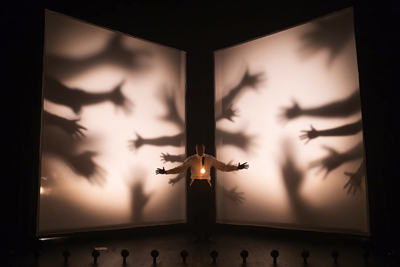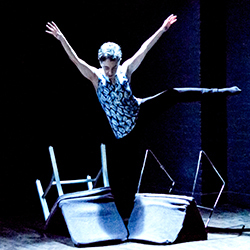Dance: Some Special Dancing Last Year (2019)
By Dawn Lille
arttimesjournal January 18, 2020
 The Black Clown |
As 2020 begins it is a pleasure to remember and record some noteworthy dance events from last year. I have memories of two emotionally moving dance theater performances and three choreographers who seemed to spring up everywhere.
Langston Hughes has long been a favorite poet, his conversational approach evoking deep feelings and sadness. One of the major figures of the Harlem Renaissance, he wanted his poetry read and understood by the negro about whom he was writing. But the simplicity of his poetry and its often- searing images are deceiving.
The Black Clown, based on his work of that name and an example of his jazz poetry, was presented in July at the Mostly Mozart Festival in a musical theater adaptation by Davóne Tines and Michael Schachter.
The poem, dating from 1931, deals with minstrelsy and, like all of its author's works portraying black life in America, it confronts the racial inequality of which black face minstrelsy was one example. The dialogue in the piece is all from the poem, which was printed in the program, along with the mood Hughes felt should go with each line. He also gave stage directions, suggested types of music and, in some of his verse, referred directly to specific dances.
The ensemble of twelve multitalented performers led by Tines, an accomplished baritone bass, was directed by Zack Winokur and choreographed by Chanel DaSilva who received the Martha Hill Mid Career Award this year. They work so well together that it was hard to tell where one left off and the other began. It was a seamless production made richer by the costumes (Carlos Soto), the lighting (John Torres) and the music score by Schachter, which showed influences of the blues and black spirituals. The eight -member orchestra was a solid support.
In an after performance talk Winokur said he took his clues from Hughes' directions but was also influenced by the silhouettes of the artist Kara Walker. To him, his job is to shorten the distance between an actor and a character. Dines expressed his desire, as both creator and actor, to present the truth of the poem, noting that the history it reveals is his. DaSilva said she wished to create an awareness of the dance forms of the 20's and 30's, and there were suggestions of soft shoe and tap. But there was also a pas de quatre from these performers who initially told her they were singers, not dancers.
Hughes' mood suggestions range from joy, to comic, to melancholy, to defiant and determined. The white costume is torn off and the poem ends
I was once a black clown
But now -
I'm a man!
This very relevant production was one of the gems of the Mostly Mozart Festival.
 Janis Brenner in Inheritance: A Litany |
Inheritance: A Litany, conceived, directed, choreographed and performed by Janis Brenner, is a small memoir about memory. After her parents died she began thinking about what they had left her: objects, ideas, attitudes, physical characteristics. In this piece Brenner, who heads her own company, talks, sings, dances and presents short tableaus.
When she opens the trunk that sits on top of a table she takes out her father's favorite records, among them The Weavers, his wallet, his walking stick. There are stock options, a savings book, and her parent's wedding photo.
While walking and moving and sculpting space, she recites a litany of her inheritance: her father's nose, chin and hair, her mother's face, skin, expressions, fragile bones and sarcasm. From both come her lack of height, sense of justice, secularism and search for adventure.
Acting out a scene of marital bickering, she whips from chair to chair portraying both her parents. At one point she sits and vocalizes, using the warm vibrating voice she inherited from her mother.
By the time this honest, evocative, well -crafted performance is over those present have shared an experience that takes them into their own lives and memories. The work won first prize when originally presented at the United Solo Festival on Theatre Row in 2018, as did its composer Jerome Begin and lighting designer Mitchell Bogard, and was brought back in two 2019 Encore performances last fall. Understandably, both sold out.
The three ever-present dance makers were Kyle Abraham, Camille A. Brown and Pam Tanowitz. Abraham has shown himself to be not only a most capable choreographer, but one who thinks intellectually about a piece before he begins. This includes the dancers on whom he creates a work when they are not his own company and historical and social issues as they relate to the present. He is not shy about sending messages either.
In fall 2018 New York City Ballet's commission from him was The Runaway, with music by Nico Muhly, Kanye West, Jay-Z and James Blake, a combination that actually worked. The ballet begins with a solo by a male dancer clad in a short tunic. He does not appear to be running away from anything, but is certainly different. The company costumes, all black and white, included hairdos for the women with a bunch of hair standing straight out from either side of their heads..
Some of the movements are reminiscent of baroque dance. Since the slaves on the plantations of the American south often mimicked the dance they saw in the main house, this could be related. I'm still thinking about that dance. Is it a satire on ballet, a comment on slavery, a plea for the freedom to be different?
 Only the Lonely (Abraham) photo credit Nina Wurtzel |
Last fall the Paul Taylor American Modern Dance Company premiered Abraham's Only The Lonely, a work for eight dancers about different forms of love, set accompanied by songs sung by Shirley Horn. In this beautiful dance he showed that he was familiar with the versatility and strength of this company, with its ability to flow from one movement to the next, and knew the works to popular songs that Taylor had created. The full range of human love revealed on the stage was a most satisfying experience.
Camille A. Brown has been making dances for herself and her company for some time. She has also choreographed Broadway and Off Broadway productions, winning many awards. This past year she distinguished herself in theater ( For Colored Girls Who Have Considered Suicide/When The Rainbow Is Enuf at The Public Theater) and opera (Porgy and Bess at the Met).
In the former she worked with a director, Leah C. Gardiner, known for her physical approach to theater, and seven actors who were kept in constant motion. The work is a choreo poem about the resilience of black women and their bodies.
Porgy and Bess is the work of singers. How they were able to move and produce such magnificent sound simultaneously was overwhelming. But Brown's deep sense of the suffering, history and humanity of the stage characters to which she is giving or eliciting movement is evident in the casual and honest manner with which each portrayal is integrated.
Pam Tanowitz has been a modern dance choreographer for over two decades. I recall seeing a work of hers in a garden in the East Village and being impressed by some of her wonderfully quirky movements. This past year it was possible to see her commissioned dances on the New York City Ballet and the Paul Taylor American Dance Company.
Most memorable, however, was New Work For Goldberg Variations , a joint venture with the impeccable pianist Simone Dinnerstein, who played all of Bach's masterpiece seated at a grand piano stage center at the Joyce Theater, while seven members of the Tanowitz company occupied the remaining space.
There are still vestiges of that early idiosyncratic movement, plus echoes of Merce Cunningham, which is not surprising since most of the performers have danced his works and Melissa Toogood, the artistic associate and rehearsal director, was a member of the Cunningham company. But this partnership, which originally premiered in October, 2017, was a most satisfying experience.
Here's hoping some great dance - and music, art, theater and literature - will help us get through 2020!
dawnlille@aol.com
